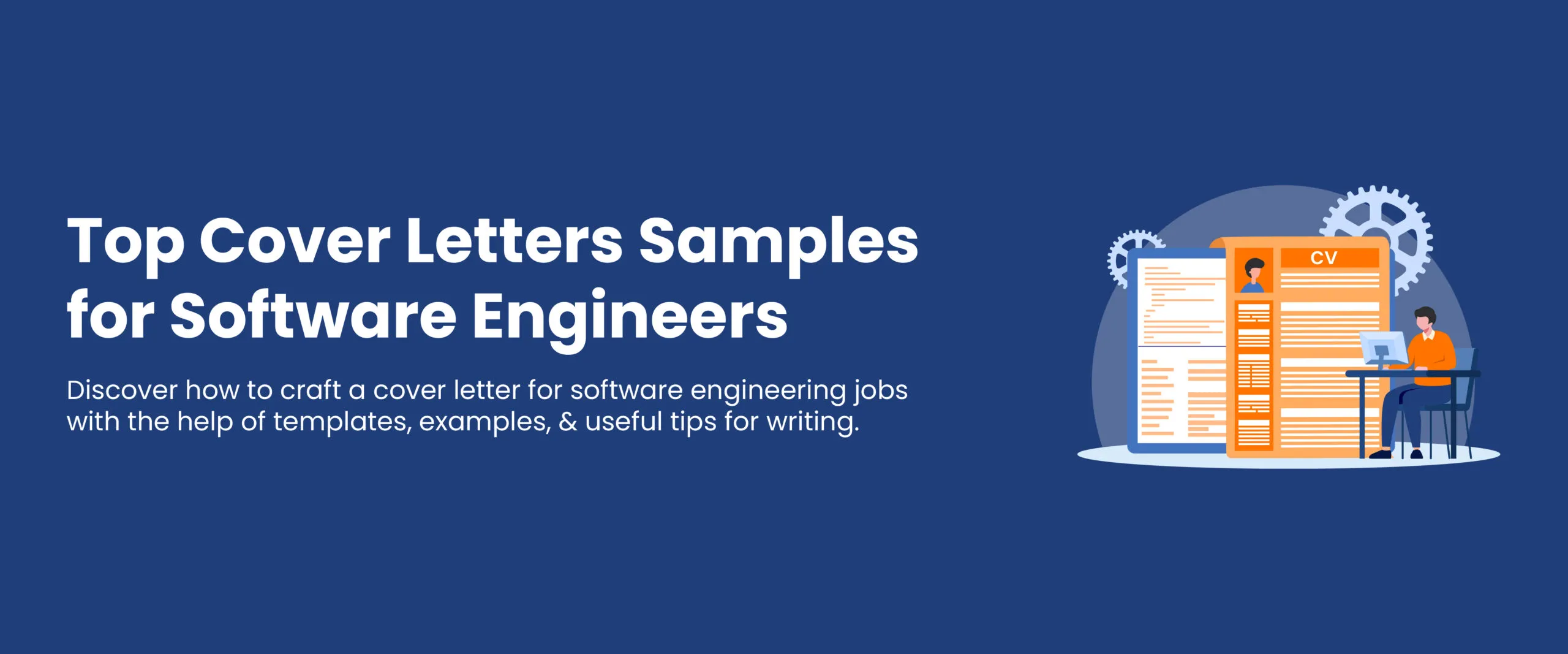Cover Letter: What Is It?
A cover letter is a crucial document that accompanies your resume when applying for a job. It serves as your first introduction to a potential employer, providing an opportunity to highlight your skills, experience, and enthusiasm for the position. Think of it as a tailored narrative that complements your resume, showcasing why you are the ideal candidate for the role. A well-crafted cover letter can significantly increase your chances of getting noticed and securing an interview. In the competitive field of software engineering, a compelling cover letter can make all the difference in landing your dream job. It allows you to personalize your application and demonstrate your genuine interest in the specific company and role.
Why Software Engineers Need Cover Letters
Software engineers often question the necessity of a cover letter, especially in an industry that values technical skills above all else. However, a cover letter provides a platform to showcase your communication abilities, personality, and passion for the field. It allows you to articulate your technical expertise in a clear and concise manner, while also demonstrating your understanding of the company’s needs and values. Furthermore, a cover letter provides an opportunity to bridge any gaps in your resume, explain career transitions, or address specific requirements mentioned in the job description. By tailoring your cover letter to each job application, you demonstrate your attention to detail and your genuine interest in the opportunity, which can set you apart from other applicants.
Key Components of a Cover Letter for Software Engineers
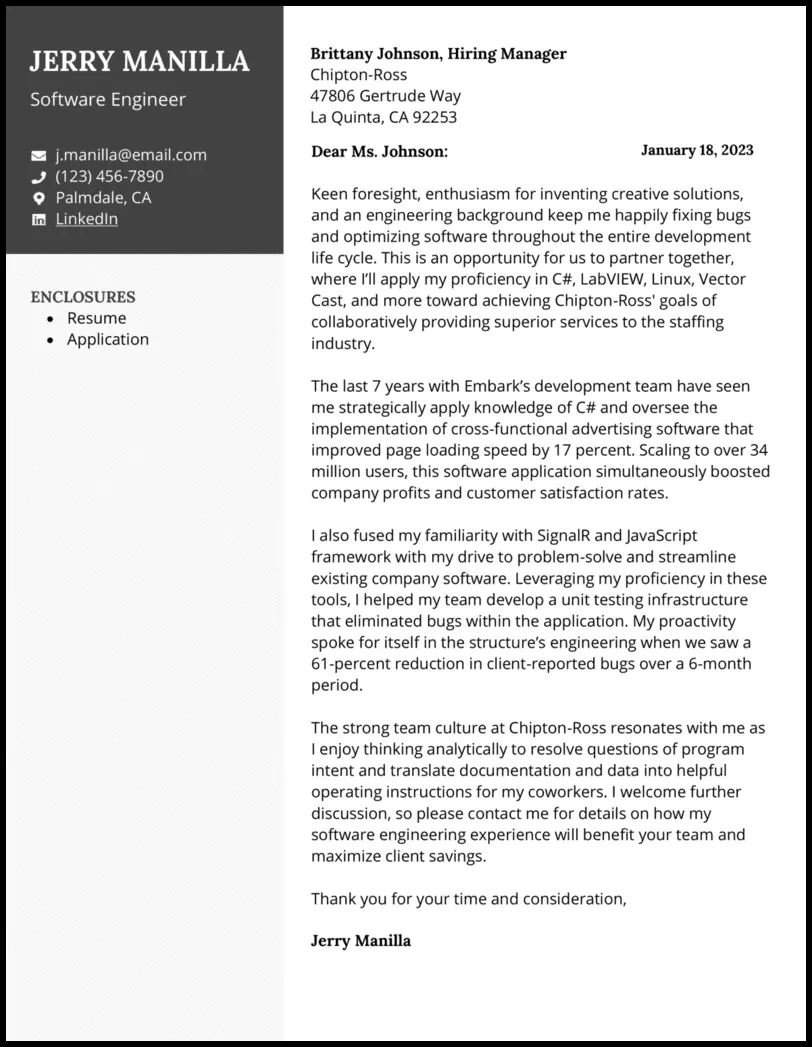
A well-structured cover letter consists of several key components that work together to create a compelling narrative. These components include the header, body, and closing sections. Each section plays a vital role in conveying your qualifications and enthusiasm to the hiring manager. The header contains essential contact information, while the body allows you to highlight your skills, achievements, and motivation. The closing reinforces your interest and includes a call to action. Mastering these components will ensure your cover letter leaves a lasting positive impression.
Header Section
The header is the first element of your cover letter and should include your contact information, the date, and the recipient’s contact information. Accuracy and professionalism are paramount here, as this section sets the tone for the entire document. Ensure that all contact details are up-to-date and that you are using a professional email address. Presenting a clean and organized header demonstrates your attention to detail and your commitment to professionalism.
Your Contact Information
Begin with your full name, followed by your address, phone number, and professional email address. It’s crucial to ensure that the contact details are current and accurate. Consider including a link to your LinkedIn profile or online portfolio to provide the recruiter with quick access to more information about your background and experience.
Recruiter’s Contact Information
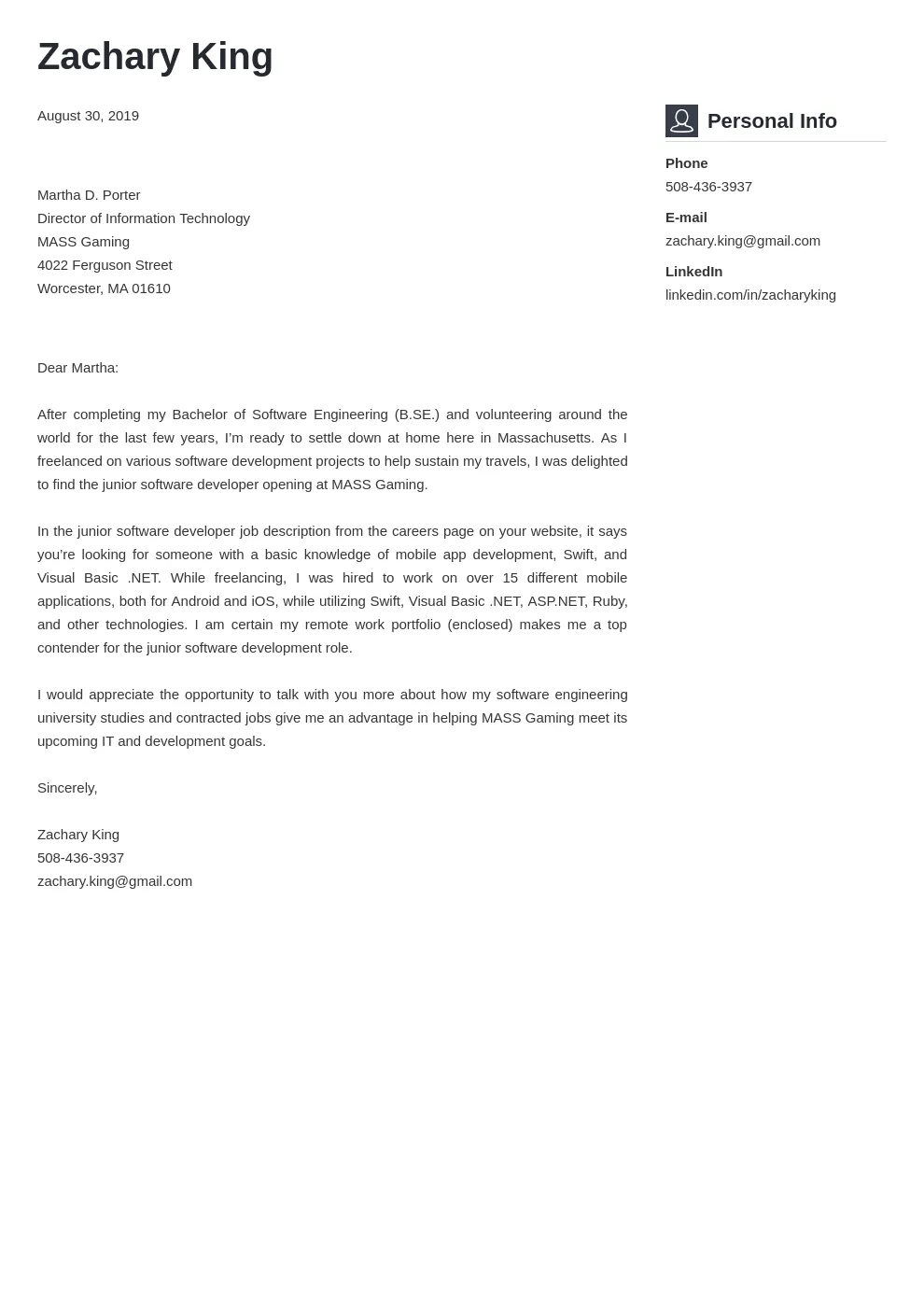
If you know the name of the hiring manager or recruiter, address the letter directly to them. This personal touch demonstrates that you have done your research and are genuinely interested in the position. If the name is unavailable, use a general salutation like ‘Dear Hiring Manager’. Always double-check the spelling of the recipient’s name and the company’s address.
Salutation
The salutation is the formal greeting that begins your cover letter. Use ‘Dear [Hiring Manager Name]’ if you know the name of the hiring manager. If the name is unavailable, use ‘Dear Hiring Manager’ or ‘Dear [Company Name] Hiring Team’. Avoid outdated salutations such as ‘To Whom It May Concern’.
Body Section
The body of your cover letter is where you showcase your skills, experience, and enthusiasm for the role. This section typically consists of three paragraphs: an introduction, a discussion of your relevant skills and achievements, and a conclusion that reinforces your interest and includes a call to action. Each paragraph should be concise, well-written, and tailored to the specific job and company. This demonstrates that you have taken the time to understand their needs and requirements.
First Paragraph
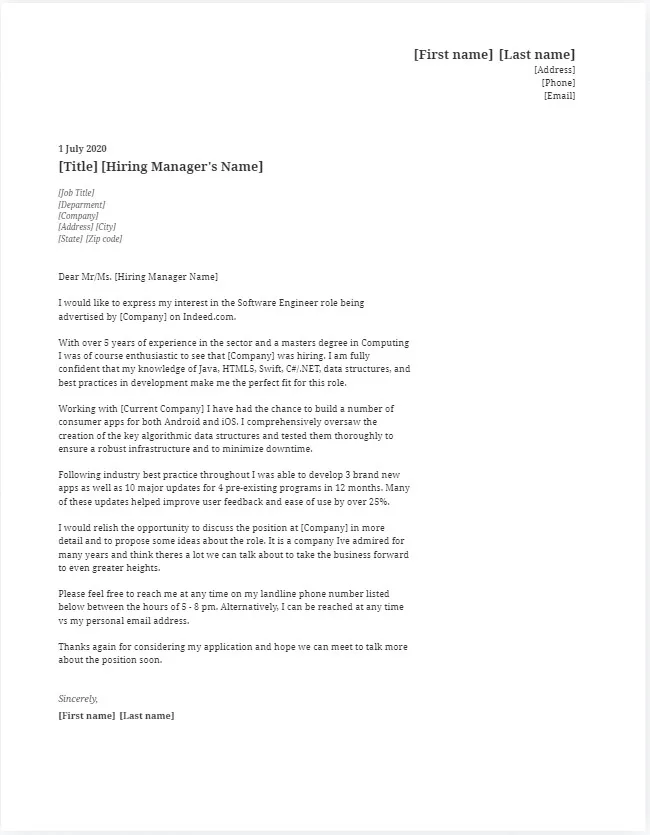
Start with a captivating introduction that grabs the reader’s attention and immediately establishes your interest in the position. State the specific role you’re applying for and where you found the job posting. Show your enthusiasm by briefly mentioning why you are excited about the opportunity and what you admire about the company. This is your chance to make a strong first impression.
Express Enthusiasm
Demonstrate your genuine excitement for the role and the company. Mention specific aspects of the company’s mission, culture, or products that resonate with you. This shows that you’ve done your research and are not simply sending out generic applications. Highlighting your enthusiasm will make you stand out from other candidates.
Highlight Relevant Skills
In the second paragraph, highlight your relevant skills and experience that align with the job requirements. Review the job description carefully and identify the key skills and qualifications the employer is seeking. Provide specific examples of how you’ve used these skills in previous roles, quantifying your achievements whenever possible. Tailor this section to match the requirements of the specific job and company.
Showcase Achievements
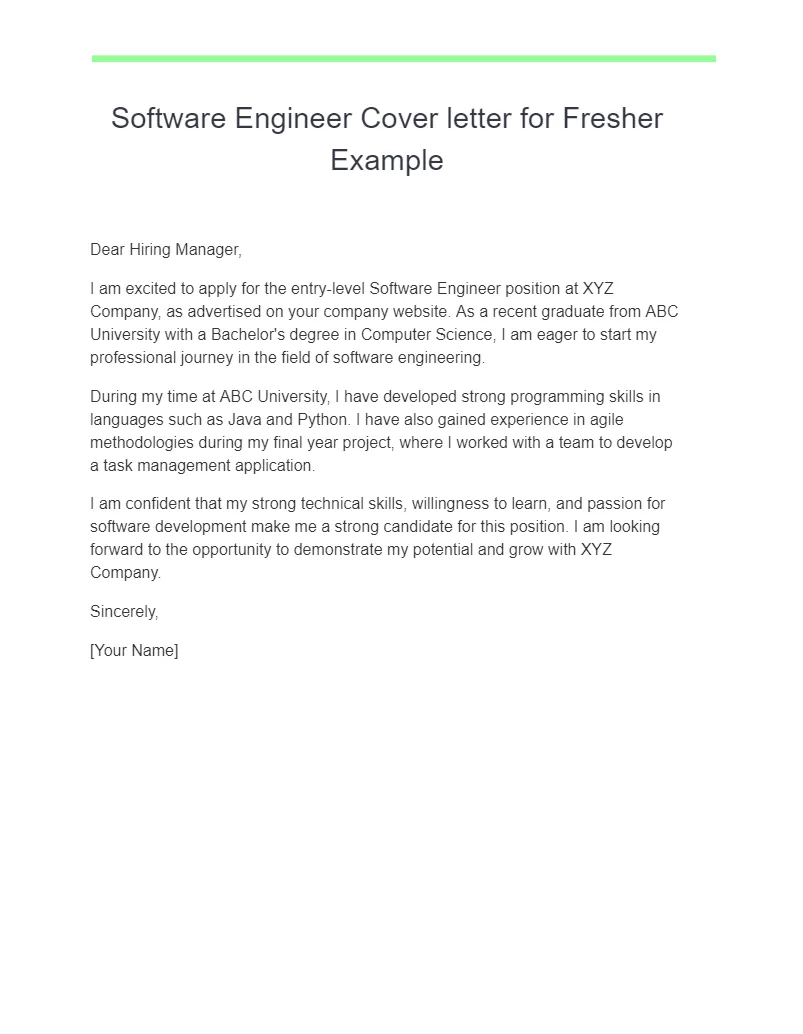
Focus on quantifiable achievements that demonstrate your ability to deliver results. Instead of simply listing your responsibilities, describe how you’ve solved problems, improved processes, or contributed to successful projects. Use the STAR method (Situation, Task, Action, Result) to structure your examples and provide a clear and concise narrative of your accomplishments. Quantifying your results with metrics will make your achievements more impactful.
Second Paragraph
In this section, delve deeper into your experience and highlight how your skills and achievements align with the company’s needs. Connect your past experiences to the specific requirements outlined in the job description. Demonstrate your ability to perform the job duties effectively and efficiently. Show the employer that you possess the necessary competencies to excel in the position. Provide details about projects, technologies, or frameworks you’ve worked with. Demonstrate how your skills can benefit the organization.
Demonstrate Company Research
Show the hiring manager that you have researched the company and understand its mission, values, and goals. Mention specific aspects of the company that appeal to you. Explain how your skills and experience align with their needs. This shows your genuine interest in the company and that you are not just applying for any job.
Explain Your Value
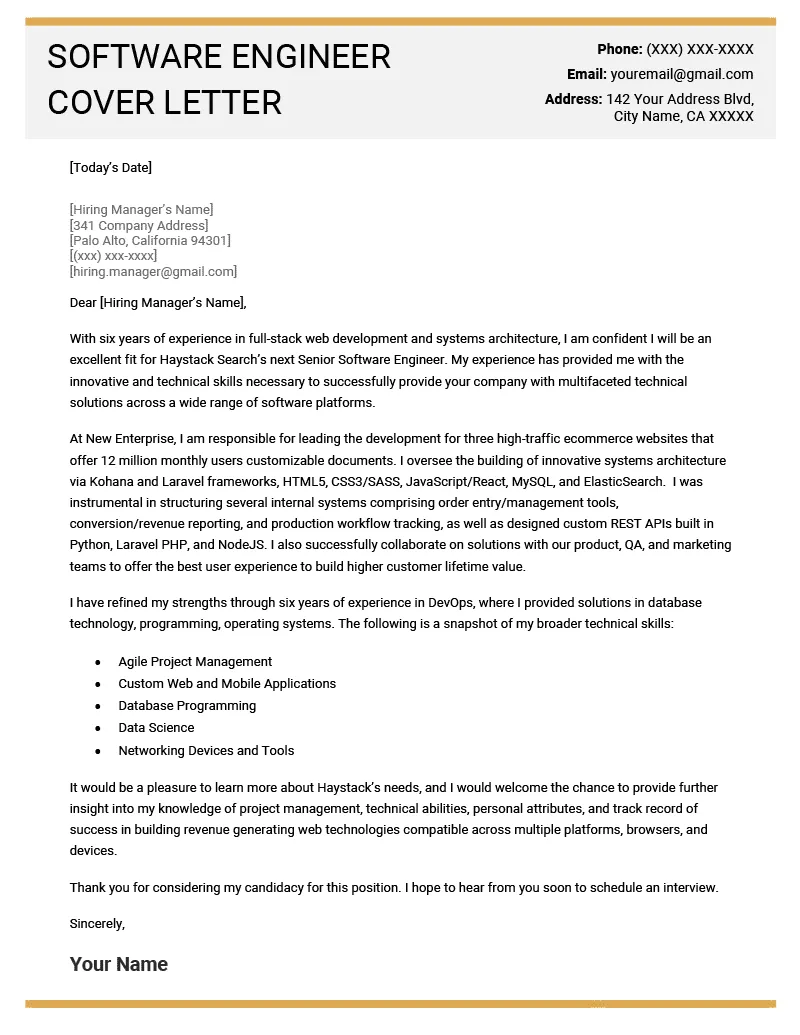
Clearly articulate the value you bring to the company. Describe how your skills and experience can help solve their problems, achieve their goals, or improve their processes. Highlight the unique contributions you can make. Demonstrate your ability to thrive within the company culture.
Third Paragraph
Conclude your cover letter by summarizing your qualifications and reiterating your interest in the position. Express your eagerness to learn more about the opportunity and the company. Thank the reader for their time and consideration. This is the final impression you leave with the hiring manager.
Call to Action
End your cover letter with a clear call to action. State your availability for an interview and express your eagerness to discuss your qualifications further. Provide your contact information again and make it easy for the recruiter to get in touch with you. This action can significantly improve your chances of moving forward in the hiring process.
Closing and Signature
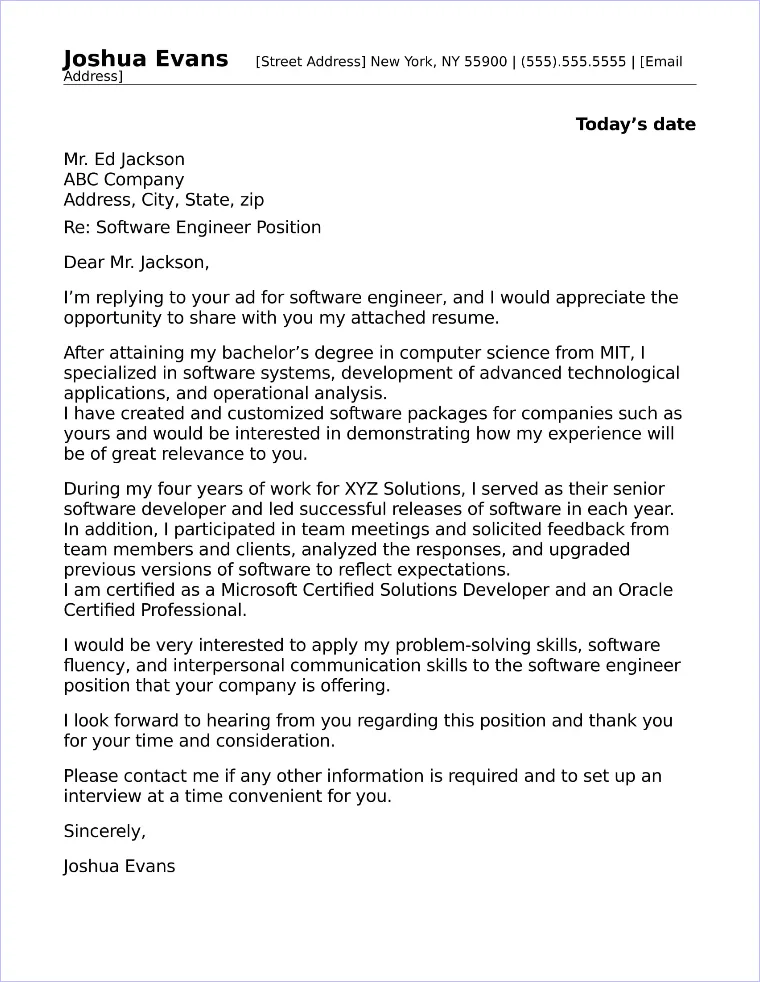
The closing and signature provide a formal end to your cover letter. Use a professional closing such as ‘Sincerely’ or ‘Best regards’. Follow your closing with your typed name. If you’re submitting a physical copy, leave space for your handwritten signature above your typed name. This adds a final touch of professionalism and formality to your cover letter.
Common Mistakes to Avoid
Several common mistakes can undermine your cover letter and reduce your chances of getting an interview. Avoiding these errors can significantly improve the effectiveness of your application. Pay close attention to details and always proofread your letter before submitting it.
Generic Content
Avoid using a generic cover letter that is not tailored to the specific job or company. Generic content lacks personalization and demonstrates a lack of genuine interest in the opportunity. Customize your cover letter for each application, highlighting your skills and experience relevant to the job description. This shows the hiring manager that you have taken the time to understand their needs and requirements.
Typos and Grammatical Errors
Typos and grammatical errors create a negative impression and undermine your credibility. Proofread your cover letter carefully before submitting it. Use a grammar checker and ask a friend or colleague to review your letter for any errors. Double-checking for accuracy is crucial, as it demonstrates your attention to detail and professionalism.
Lack of Customization
Failing to customize your cover letter for each job application is a missed opportunity. Tailor your letter to each specific job description, highlighting the skills and experience most relevant to the role. Research the company and demonstrate your understanding of their values and goals. Customized content shows that you are genuinely interested in the opportunity and have taken the time to learn about the company.
Formatting Issues
Poor formatting makes your cover letter difficult to read and can detract from your message. Use a professional font, such as Times New Roman, Arial, or Calibri, and maintain a consistent font size. Use clear headings and subheadings to organize your content, and keep the paragraphs concise and well-spaced. Proper formatting enhances readability and makes a positive impression on the reader.
Cover Letter Template for Software Engineers
A well-designed template can help you create a professional and effective cover letter quickly and easily. Many templates are available online, or you can create your own using a word processor. When choosing or creating a template, make sure it is clean, modern, and easy to read. Personalize the template to reflect your personality and brand.
Customizing the Template
Once you have a template, the next step is to customize it to match your qualifications and the specific job you are applying for. Add your contact information, address the letter to the hiring manager (if known), and replace the placeholder text with your own content. Tailor each section to highlight your relevant skills and experiences. This will make your cover letter unique and tailored to the specific opportunity.
Reviewing and Editing
After customizing your cover letter, review it thoroughly. Check for any typos, grammatical errors, or formatting issues. Ensure that the content is clear, concise, and tailored to the job requirements. It is advisable to have a friend or career counselor review your letter for feedback. Make revisions as needed and create your best cover letter.
Final Thoughts
A winning cover letter is an essential tool in your job search arsenal. By following the guidelines and tips outlined in this guide, you can create a cover letter that will impress hiring managers and increase your chances of landing an interview. Remember to customize your cover letter for each job application, highlight your skills and achievements, and proofread carefully. With a well-crafted cover letter, you’ll be well on your way to securing your dream job in software engineering.
